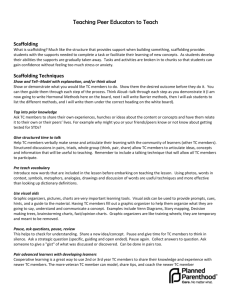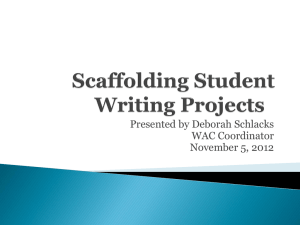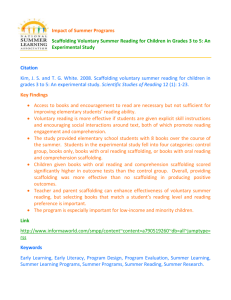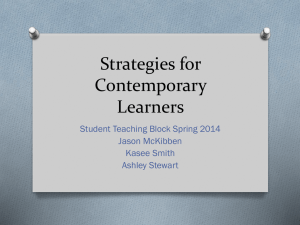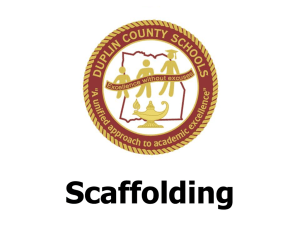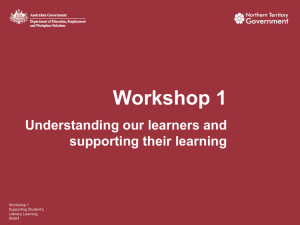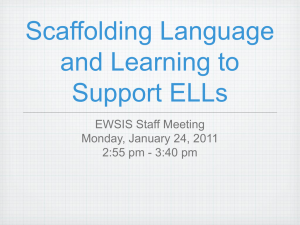Workshop 1 - Participant`s workbook
advertisement
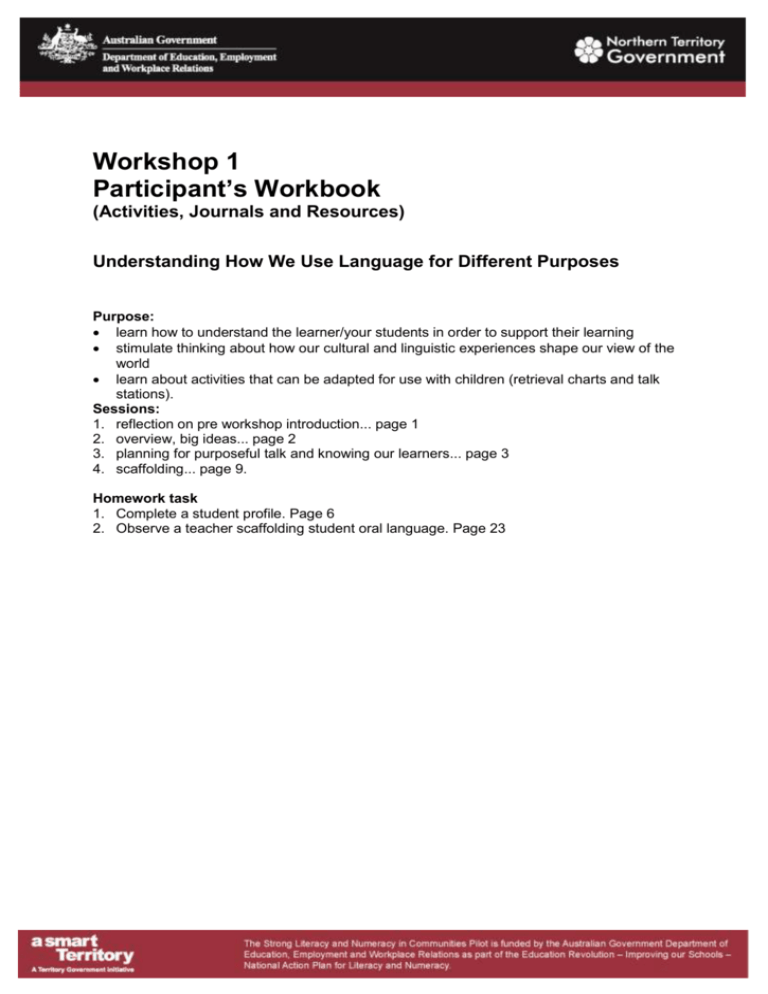
Workshop 1 Participant’s Workbook (Activities, Journals and Resources) Understanding How We Use Language for Different Purposes Purpose: learn how to understand the learner/your students in order to support their learning stimulate thinking about how our cultural and linguistic experiences shape our view of the world learn about activities that can be adapted for use with children (retrieval charts and talk stations). Sessions: 1. reflection on pre workshop introduction... page 1 2. overview, big ideas... page 2 3. planning for purposeful talk and knowing our learners... page 3 4. scaffolding... page 9. Homework task 1. Complete a student profile. Page 6 2. Observe a teacher scaffolding student oral language. Page 23 Session 1: Reflection on pre workshop introduction Using the Pre Workshop Introduction, Participant’s Workbook you will reflect on the information in it. This will provide an opportunity to raise questions or matters that need clarification. Session 2: Overview, Big Ideas, Workshop One Course Overview Knowing about our learners Scaffolding learning Helping children’s oral language development and links to learning Helping children learn to read Helping children learn to write Session 3: Planning For Purposeful Talk & Knowing Our Learners Getting to know each other – A example of how to encourage purposeful talk In the workshop write the following on the 7 post it notes Your name Where you were born Your interests outside work Languages that you speak What your job is Number of months or years worked in schools What you hope to learn from this course Retrieval Charts / Information Grids: Retrieval charts and information grids are examples of graphic organisers. They are a very useful tool for organising information and for helping students to structure their thinking. They can also support students to develop oral, reading and writing skills. Name Where you were born Interests outside of work Languages that you speak Job Number of years I have worked in schools What I want to learn from the course Talk Stations; An explanation Talk stations are an activity to engage learners and to develop oral communication skills of both speaking and listening. This strategy encourages learners to talk and listen in the supportive environment of a small group. 2|W orkshop 1: Participant’s W orkbook Questions or statements, linked to the topic being discussed in class are composed by the teacher/ facilitator. Talk stations are used to set the scene of the concepts to be covered, and so allows all students to make links to their prior knowledge about the new class topic. In groups of 3, one student talks about a statement, while the other 2 group members listen. Each group member has a turn of speaking about a different topic/ statement/ question. After each group member has spoken the groups are moved on, and the members of the next group repeat the process, in turn, with new statements/ questions. Talk Stations topic sheet at this workshop: Round 1 Red Topic: The best things about living where I do are ... Green Topic: My earliest memories of school are ... Blue Topic: A challenging experience I had meeting people from a different culture was ... Round 2 Red Topic: In my family, when I was a child, literacy meant ... Green Topic: Working with children, I think my strengths are ... Blue Topic: One thing I wish I had learned as a child is ... Round 3 Red Topic: I think children learn best when ... Green Topic: Some interesting things I have learned about the cultural background of one of the children I work with are ... Blue Topic: The best things about where I work are ... Write notes below if needed: .................................................................................................................................................................................... .................................................................................................................................................................................... .................................................................................................................................................................................... .................................................................................................................................................................................... .................................................................................................................................................................................... .................................................................................................................................................................................... .................................................................................................................................................................................... 3|W orkshop 1: Participant’s W orkbook What did I learn? After each session we will take the time to reflect on our learning using the Tribes model below. The aim of the “What did I learn?” section at the end of each session is to give participants time to reflect on: what you have learned in each session the skills and knowledge you needed to have to be able to participate in the session any assistance you required how you felt after completing the activity/session whether you have seen the strategy/skill/activity used in your workplace how you could use/adapt what you have learned to your own work The “What did I learn?” sections will follow a pattern of: “community circle” where each participant is given the opportunity to talk about the reflection questions journal writing time where participants can work in pairs or individually to write about or visually represent their learning and feelings. Source: Jeanne Gibbs (2001) Tribes: A New Way of Learning and Being Together. Center Source Systems, LLC, California 4|W orkshop 1: Participant’s W orkbook Community circle What did you learn from this session? What skills/help/understandings did you need to be able to participate in the activities? During the ‘talk stations’ activity, why do you think only one person was allowed to speak while the other two had to listen and/or ask clarifying questions? Do all the children you work with come from the same cultural or linguistic background to your own or to the teacher’s? What do schools need to know about their students’ family, cultural and linguistic background and experiences? How can this knowledge help you with the work you do with children? Where would you find this information? How did you feel while doing and / after completing the session? Have you seen retrieval charts/information grids being used in the classroom? Have you seen or used ‘talk stations’ in the classroom. Were they successful/not successful with students? Why? Could you use/adapt the activity in the work you do with students? Journal entry Make notes (in writing or drawing below) about these questions. You can work with another person or individually. (5 minutes) JOURNAL .................................................................................................................................................................................... .................................................................................................................................................................................... .................................................................................................................................................................................... .................................................................................................................................................................................... .................................................................................................................................................................................... .................................................................................................................................................................................... .................................................................................................................................................................................... .................................................................................................................................................................................... .................................................................................................................................................................................... .................................................................................................................................................................................... .................................................................................................................................................................................... .................................................................................................................................................................................... .................................................................................................................................................................................... .................................................................................................................................................................................... .................................................................................................................................................................................... .................................................................................................................................................................................... 5|W orkshop 1: Participant’s W orkbook Homework Task – Student profile Compile student profiles - Find out about two students. Discuss this task with the teacher to identify which students to focus on and to discuss the sources for the information you have listed below. If you are going to approach the student directly this will need to be done sensitively and preferably after you have tried all other means of gathering information. A guide to the type of information you may collect is supplied on the next page. Note: Many schools already have a version of this. If your school has such a document you might like to compare it with the example and identify any similarities and differences. Has useful/important information been missed out on either vers ion? It may be that you already know all the students very well. Does the classroom teacher know them as well as you? If not could you provide the teacher with a completed student profile? 6|W orkshop 1: Participant’s W orkbook Student Profile – an example Name (Use a different name for privacy) Other names Date of birth Place of birth Languages spoken at home Mother’s country, language Father’s country, language Languages spoken by student Languages understood by student Who does the child live with (extended family) Siblings / close family members at school Places / communities the child travels to Schools attends / Attendance history. Cultural / ancestral background This information was gathered from the following sources (please list): Your signature Teacher verification: this information was gathered about actual students Teacher’s signature 7|W orkshop 1: Participant’s W orkbook Additional Reading (Optional) What do you know about the learners in your class? Cultural Considerations The following are some examples of cultural considerations (Vaugn, Bos & Schumm, 2003) that influence how students learn: Time: How do students perceive time? How is timeliness regarded in their cultures? Space: What personal distance do students use in interactions with other students and with adults? How does the culture determine the space allotted to boys and girls? Dress and Food: How does dress differ for age, gender, and social class? What clothing and accessories are considered acceptable? What foods are typical? Rituals and Ceremonies: What rituals do students use to show respect? What celebrations do students observe, and for what reasons? How and where do parents expect to be greeted when visiting the class? Work: What types of work are students expected to perform, and at what age, in the home and community? To what extent are students expected to work together? Leisure: What are the purposes for play? What typical activities are done for enjoyment in the home and community? Gender Roles: What tasks are performed by boys? By girls? What expectations do parents and students hold for boys’ and girls’ achievements, and how does this differ by subject areas? Status: What resources (e.g., study area and materials, study assistance from parents and siblings) are available at home and in the community? What power do parents have to obtain information about the school and to influence educational choices? Goals: What kinds of work are considered prestigious or desirable? What role does education play in achieving occupational goals? What education level do the family and student desire for the student? Education: What methods for teaching and learning are used in the home (e.g., modelling and imitation, didactic stories and proverbs, direct verbal instruction)? Communication: What role does verbal and nonverbal language play in learning and teaching? What roles do conventions such as silence, questions, rhetorical questions, and discourse style play in communication? What types of literature (e.g., newspapers, books) are used in the home and in what language(s) are they written? How is writing used in the home (e.g., letters, lists, notes) and in what language(s)? Interaction: What roles do cooperation and competition play in learning? How are children expected to interact with teachers? (pp. 273-274) (Copyright pending) © ‘Teaching Exceptional, Diverse, And At-risk Students In The General Education Classroom’,3e, by Vaugn, Bos, & Schumm, used by permission. UNESCO, 2004, Changing Teacher Practices: Using curriculum differentiation to respond to students’ diversity, Paris,p.17 8|W orkshop 1: Participant’s W orkbook Session 4: Scaffolding Activity 1: Thinking about learning For example riding a bike, learning to swim. Table 1: Complete as a whole group. Take notes if you wish. What was the skill? Why did you want/need to learn it? Had you seen others use that skill? How did the person teaching you demonstrate to you? How were you supported to learn the new skill? What were the steps? At what point did you use the new skill independently? Did the person teaching you have to tell you to do it independently? Were you able to successfully do it or did you need to get some more help? What were your feelings about learning the new skill? If the learning was not successful, why do you think this was so? 9|W orkshop 1: Participant’s W orkbook Table 2: Complete in pairs. Think about something you learned in a more formal situation, in a class e.g. computer skills/ making a power point, learning a new language, a musical instrument or to sew. What was the skill? Why did you want/need to learn it? Had you seen others use that skill? How did the person teaching you demonstrate to you? How were you supported to learn the new skill? What were the steps? At what point did you use the new skill independently? Did the person teaching you have to tell you to do it independently? Were you able to successfully do it or did you need to get some more help? What were your feelings about learning the new skill? If the learning was not successful, why do you think this was so? 10 | W o r k s h o p 1 : P a r t i c i p a n t ’ s W o r k b o o k Table 3: Complete individually. Think of a skill you taught someone else What was the skill? Why did you want/need to teach it? Had the learner seen others use that skill? How did you demonstrate to the learner? How did you support the learner to learn the new skill? What were the steps? At what point did the learner use the new skill independently? Did you have to tell the learner to do it independently? Were they able to successfully do it or did you need to give some more help? What were your feelings about teaching the new skill? How did teaching that skill help you to do other things? How did the learner feel? If the learning was not successful, why do you think this was so? 11 | W o r k s h o p 1 : P a r t i c i p a n t ’ s W o r k b o o k What did I learn? Community circle What did you learn from this session? What skills/help/understandings did you need to be able to participate in the activities? How did you feel while doing and / after completing the session? Have you ever reflected on learning and teaching new skills in such a way? Will such reflection be useful to you in your work? Journal entry Make notes (in writing or drawing below) about these questions. You can work with another person or individually. (5 minutes) JOURNAL .................................................................................................................................................................................... .................................................................................................................................................................................... .................................................................................................................................................................................... .................................................................................................................................................................................... .................................................................................................................................................................................... .................................................................................................................................................................................... .................................................................................................................................................................................... .................................................................................................................................................................................... .................................................................................................................................................................................... .................................................................................................................................................................................... .................................................................................................................................................................................... .................................................................................................................................................................................... .................................................................................................................................................................................... .................................................................................................................................................................................... .................................................................................................................................................................................... .................................................................................................................................................................................... .................................................................................................................................................................................... 12 | W o r k s h o p 1 : P a r t i c i p a n t ’ s W o r k b o o k Activity 2: The Theory of Scaffolding Look at the picture and think about what scaffolding is used for? What is it? Jot down notes, key words, examples that come to mind ........................................................................................................................ ....................................................................................................................... ........................................................................................................................ ....................................................................................................................... ........................................................................................................................ ........................................................................................................................ Now read the following article about Scaffolding as we use it in education and in the space provided after the article note down five points you think are most important. Scaffolding What is scaffolding? “Scaffolding refers to support that is designed to provide the assistance necessary to enable learners to accomplish tasks and develop understandings that they would not quite be able to manage on their own. It is not just any assistance to help a learner accomplish a task. It is help which will enable a learner to accomplish a task which they would not have been quite able to manage on their own. It is help that is intended to bring the learner closer to a state of competence to enable them eventually to complete such a task on their own” (Hammond & Gibbons 2001). What does scaffolding do? supports learning through speaking, listening, reading, viewing and writing across all learning areas allows the curriculum to be enriched, not simplified gives opportunities for exploration and clarification provides for guided practice revisits the concepts ‘unpacks’ the subject (ways of thinking and the language involved). What is the purpose of scaffolding? The purpose of scaffolding is to allow learners to do as much as they can on their own and then for the teacher to intervene and provide assistance when it is needed so that the task can be successfully completed. This assists learners to move from the ‘zone of actual development’ to the ‘zone of proximal development’ (Vygotsky 1978), so that the task can be completed independently. Scaffolding is designed to help learners know not only what to think and do, but how to think and do so that new skills and understandings can be applied in new contexts. “Learning always proceeds from the known to the new. Good teaching will recognise and build on this connection.” www.myread.org 13 | W o r k s h o p 1 : P a r t i c i p a n t ’ s W o r k b o o k What does the teacher do? The teacher provides assistance and support that is designed to help learners move towards new skills, concepts or understandings. Classroom scaffolding is much more than encouragement, management or confirmation of learning. Source: ESL FundameNTals Five points you think are most important in the reading you have just done: 1. ..................................................................................................................................................................... 2. ..................................................................................................................................................................... 3. ..................................................................................................................................................................... 4. ..................................................................................................................................................................... 5. ..................................................................................................................................................................... Copy your group’s definition of scaffolding: ...................................................................................................................................................................................................... ...................................................................................................................................................................................................... ...................................................................................................................................................................................................... ...................................................................................................................................................................................................... ...................................................................................................................................................................................................... ...................................................................................................................................................................................................... On the next page is a blank example of how young learners are supported through their learning, using a scaffolded sequence of teaching and learning. Cut up the boxes in the handout given to you by the facilitator and glue into the correct sequence. 14 | W o r k s h o p 1 : P a r t i c i p a n t ’ s W o r k b o o k Lesson: Introducing Time Lines Getting ready A Show me how (modelling) B Help me do it (guided practice) C Let me do it myself (independent practice) D What did I learn? E NTCF Curriculum Support Materials, teaching resources for Indigenous students, Maths, http://www.det.nt.gov.au/teachers-educators/curriculum-ntbos/support-materials 15 | W o r k s h o p 1 : P a r t i c i p a n t ’ s W o r k b o o k Remind the participants that the teaching-learning sequence has been designed using a scaffolded sequence of activities and has been used for all the workshop sessions and activities you have already participated in up to this point. 16 | W o r k s h o p 1 : P a r t i c i p a n t ’ s W o r k b o o k What did I learn? Community circle What did you learn from this session? What skills/help/understandings did you need to be able to participate in the activities? How did you feel while doing and / after completing the session? Could you use/adapt the think-pair-share activity for the students you work with? Journal entry Make notes (in writing or drawing below) about these questions. You can work with another person or individually. (5 minutes) JOURNAL .................................................................................................................................................................................... .................................................................................................................................................................................... .................................................................................................................................................................................... .................................................................................................................................................................................... .................................................................................................................................................................................... .................................................................................................................................................................................... .................................................................................................................................................................................... .................................................................................................................................................................................... .................................................................................................................................................................................... .................................................................................................................................................................................... .................................................................................................................................................................................... .................................................................................................................................................................................... .................................................................................................................................................................................... .................................................................................................................................................................................... .................................................................................................................................................................................... .................................................................................................................................................................................... .................................................................................................................................................................................... 17 | W o r k s h o p 1 : P a r t i c i p a n t ’ s W o r k b o o k Activity 3: Scaffolding in practice Parents have already taught their children to speak and listen by: Expecting them to speak Providing models of how spoken language works Demonstrating how to listen Supporting their attempts with praise Strategy Being an active listener Asking open ended questions Repeating new language Rephrasing and modelling Extending Pause-prompt-praise You can support children in the classroom by: asking open-ended questions repeating new language rephrasing and modelling pause-prompt-praise extending being an active listener Example Nodding, eye contact with speaker, smiling, gestures, Repeating words said, word for word, rephrasing what was said, respond with comment or question Examples of open ended questions include: How will you...? What happened after...? List all of the... How did...? Can you tell me...? How many ways can...? What would happen if...? Why do you think...? How did you feel when...? Child: Her in Hostabul Adult: Yes, she went to the hospital. Child: trimba Adult repeats word and may define: Did you know timber is the wood from trees? Student:- big monster, big and fat, very good Adult: Oh! You liked the big monster, because he was big and fat. The big hairy monster was big and fat. He did good things for other people (in the village) Pause: Wait for child to think Prompt: Help the child by giving a key word, or sound, or starting a sentence Praise: Praise their efforts. Remember to praise the behaviour not the child e.g. say “You spoke very clearly” (and smile) don’t just say “Good girl” 18 | W o r k s h o p 1 : P a r t i c i p a n t ’ s W o r k b o o k Oral Language Transcript 1 Talking about a book the class is familiar with and after an excursion into the school grounds looking for caterpillars. T: Tell me about the story S: Hungry Caterpillar T: What happens in this story? S: Um he can eat food an leaf. Um and he can eat umm some strawberries and he can turn to the um fly T: The caterpillar ate some food. He ate a leaf. He ate some strawberries. He turned into a butterfly S: There’s a egg T: (Nods)There’s a little, tiny egg S: At today there was a little tiny egg tiny egg! T: Today, on a leaf, there was a little tiny egg. S: Eating some ... Oh ... He eat one apple (looking at wrong page). He was looking for food and he eat first one apple. Hey he needs the other one T: He is looking for food. First he ate one apple, but he was still hungry. (T points to page) He needs more food. S: He full he eain one cup cake one ice-cream one pickle one cheese and one stotis (sausage) and ones um lolipo (lollipop) one pizza one stotis one cup cake one walemelon Ohhhh (big sigh) T: Thats right. He ate one cupcake, one icecream, one pickle, one piece of cheese and one sausage. He was still hungry so he ate one lollipop, one pizza and some watermelon. He was so full S: He wanna find some food and eat someping else an he wanna go back home now cos he’s fat like like his Mummy. Ecause he need a eat lots a foods T: He ate lots of food, and grew very fat. Then he went home and built a house called a cocoon. S: Yeah I know it. Ummmm. Des is fo des is for eating some food an an your an your full an you’re all an you’re all full an you’re fat T: That’s right. He puts the food in his mouth. He eats and eats and gets full. He grows very fat because he is eating lots of food. S: Umm. Eating. Ecause calapillas can eat anything. T: In this book the caterpillar eats everything. What do you think real caterpillars eat? S: Long pause... ummm T: Do they eat this kind of food? S: (Nods, smiles )and says No . Key Pause prompt praise Rephrasing and modelling Active listening Open ended question Use highlighters to show key. 19 | W o r k s h o p 1 : P a r t i c i p a n t ’ s W o r k b o o k Extending Oral Language Transcript 2 Talking about a book the class has been reading over 2 weeks. T: Look at the book The crocodile is sleeping. OOOHHH, don’t wake him up. (T puts finger to mouth and says SSSSHHHHH) Turns the page Who’s asleep now? S: Kangaroo T: (Teacher nods) Yes the kangaroo is sleeping. Can you see anyone else sleeping? S: Ummmm.... Wally wombat.... T: Yes, look at Wally Wombat here (Points to page) He’s sleeping Who else is in this book? S: umm ..... a bat T: This animals is not a bat. Its a furry animal that lives in a tree ... (pause)...and it starts with a K .... kkkk ... (pause) S: Koala bear? T: Yes, (smiles) that’s right. A koala. The koala is sleeping. S: Yeah (and actions curled up) T: He’s all curled up (Copies student’s actions) S: He’s scratching his back becos .... um ... becos ...um.... the little baby’s living in back with baby T: Yes, the babies do spend a lot of time on their mum’s back. They hang on to their mum’s back, don’t they and the mum crawls up the tree S: and choke him T: I think they try not to choke their Mum. They hang on gently like that. S: Becos they hold them over there (Student points at her chest) T: Yes, the babies hold onto their Mum’s chest S: Becos they got sharp nails T: Yes, they’ve got very sharp claws. You’ve got to be careful when you pick up a koala because they can scratch you with their sharp claws. S: Becos ... um ... becos .... um ... my sister had a koala bear T: your sister had a koala? S: and a snake ... a long one and she hold .. um... becos my sister ... um... my sister lib in Cairns Key Pause prompt praise Rephrasing and modelling Active listening Open ended question Use highlighters to show key. 20 | W o r k s h o p 1 : P a r t i c i p a n t ’ s W o r k b o o k Extending Class activity Strategy Asking open ended questions Examples of language used Repeating new language Rephrasing and modelling Extending Pause-prompt-praise Being an active listener 21 | W o r k s h o p 1 : P a r t i c i p a n t ’ s W o r k b o o k Community circle What did you learn from this session? What skills/help/understandings did you need to be able to participate in the activities? How did you feel while doing and / after completing the session? Have you ever observed the language used by students before? If so how did it help you to find out more about your students? Will you use/adapt such observation strategies with your students? Journal entry Make notes (in writing or drawing below) about these questions. You can work with another person or individually. (5 minutes) JOURNAL .................................................................................................................................................................................... .................................................................................................................................................................................... .................................................................................................................................................................................... .................................................................................................................................................................................... .................................................................................................................................................................................... .................................................................................................................................................................................... .................................................................................................................................................................................... .................................................................................................................................................................................... .................................................................................................................................................................................... .................................................................................................................................................................................... .................................................................................................................................................................................... .................................................................................................................................................................................... .................................................................................................................................................................................... .................................................................................................................................................................................... .................................................................................................................................................................................... .................................................................................................................................................................................... .................................................................................................................................................................................... 22 | W o r k s h o p 1 : P a r t i c i p a n t ’ s W o r k b o o k Homework Task – Scaffolding Write examples of these scaffolding strategies as you observe them in the classroom Talk to the teacher about the homework task, the ways they use questioning techniques to scaffold learning, other scaffolding used by the teacher, and particular children that require a lot of scaffolding. Strategy Being an active listener Examples of language used Asking open ended questions Repeating new language Rephrasing and modelling Extending Pause-promptpraise Other strategies observed After the observation please ask your teacher to sign this page as an accurate observation – Try for one example of each strategy. Write N/A in sections where it wasn’t observed. Teacher Verification .......................................................................................................... 23 | W o r k s h o p 1 : P a r t i c i p a n t ’ s W o r k b o o k Date .................... Glossary Add unfamiliar words to this list, and use a dictionary to find the meanings OR Write the word or phrase on a post it note and add it to the Glossary poster in the room. 24 | W o r k s h o p 1 : P a r t i c i p a n t ’ s W o r k b o o k
